
アキバから、世界へ!
From Akiba to the World!
Striving to Become a Top Digital Content Hub
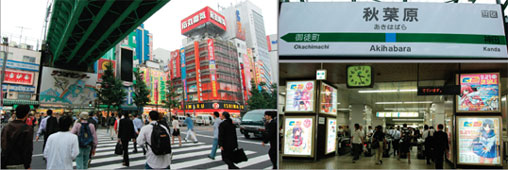
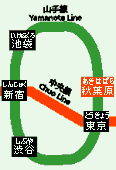
Akiba is the nickname of Akihabara, the commercial area of
approximately 500 meters square centered on Akihabara station (Chiyoda Ward,
Tokyo) on the JR train line. There are roughly 600 shops of various sizes
that carry household appliances, audio equipment, computers, and electronics
parts, packed with customers from both Japan and abroad. Recently, stores
specializing in computer-game software and DVD's, as well as anime-related
paraphernalia and character figurines targeting respective mania
(enthusiasts) have been attracting attention.
JR Akihabara station is about five minutes by train from Tokyo Station on the
Yamanote line.
Electrical parts district ⇒ household appliance district ⇒ computer district ⇒ otaku mecca ⇒ major IT industry hub
| 1945-1954 (Showa Twenties) | 1985-1989 (Showa Sixties) |
| ■The location of electrical parts wholesalers during the first decade following the end of World War II, Akihabara attracted retailers from various parts of the country with its low prices and easy accessibility by train. In the days when it became popular to build radios by hand at home and vacuum tubes were in high demand,street vendors selling radio parts gathered in Akihabara. With prohibition of openair markets by the Allied Occupation in 1949, the vendors moved to spots under the train overpasses and in nearby buildings. This was the beginning of today's Akihabara. | ■Audio-visual equipment such as VCRs and CD players, as well as informationrelated household appliances including word processors and cordless telephones became a huge hit. With the burgeoning of the bubble economy, even expensive products sold quickly. |
| 1990-2005 (Heisei) | |
■The appearance of the Windows computer set off the personal computer boom and stores specializing in personal computers (PCs) opened in Akihabara. In 1994, sales of PC-related products surpassed that of other household appliances, thus making Akihabara into a center of the PC retail market. ■Mass retailers and discount stores carrying household appliances and computers opened in city centers like Shinjuku and Ikebukuro, and the suburbs. Akihabara lost its appeal as a unique electronics district where products were available for lower-than-market prices, and failed to keep customers. ■There were many computer game fans among computer users, and these fans were also enthusiasts of the anime and manga related to these games. Although computer sales leveled off, sales of game software along with anime and manga goods continued going strong, and from around 1997, the number of stores carrying manga, fanzines, anime paraphernalia, figurines, and DVD software increased. Because of the many large-scale stores with wide selections of products and smaller stores carrying rare products with appeal to hobbyists, many otaku began to gathering Akihabara. Signs and posters depicting game and anime characters were found all over the area. Akihabara became an otaku hub. ■With the redevelopment of the JR Akihabara station area, there is great hope that Akihabara will become a major hub of the IT industry, serving as a source of cutting edge technology and Japanese software to the rest of the world. |
|
| 1955-1964 (Showa Thirties) | |
| ■Black and white televisions, electric-powered refrigerators, and electric washing machines, the so-called three sacred treasures of modern convenience, became symbols of the comfortable life. The number of wholesalers and retailers of household appliances in Akihabara increased. | |
| 1965-1974 (Showa Forties) | |
| ■By 1970, 91.7 percent of Japanese households owned a black and white television set. Then color television was introduced, and the color television became one of the "new three sacred treasures," along with the air conditioner and automobile.The rapid economic growth period kicked off an era of mass production and mass consumption. As the needs of consumers diversified, household appliance stores in Akihabara grew bigger, and many new buildings were built. | |
| 1975-1984 (Showa Fifties) | |
| ■Japan's first "maikon" (personal computer) store opened in 1976, and the number of such stores steadily rose thereafter. Two oil crises (in 1993 and 1979) and the deterioration of the environment encouraged conservation and energysaving. The label "Made in Japan" became a symbol of high-quality electric and electronics products, and tourists and businessmen from overseas began to shop in Akihabara for Walkman portable stereos and household appliances to take home as gifts. |
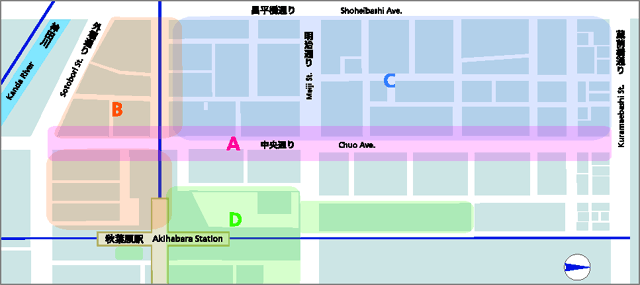
A. Main Street Area
Large-scale stores selling household appliances and computers, game software and DVD's, and manga- and anime-related goods line both sides of the main street in Akiba. On Sundays and holidays, the road is closed off to vehicles.
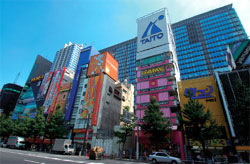
Main Street
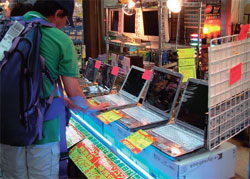
PC store
B. Electronics District Area
The area just outside the JR Akihabara Station Denkigai (Electronics District) Exit. Underneath the overpass are stores selling electronic parts reminiscent of the stores in the immediate postwar era. There are also many duty-free shops catering to tourists from overseas. Of the shops in the Radio Kaikan building, which has been around for a long time, the majority once sold electric parts. With the passing of time, most stores carried household appliances and computers, and now, stores specializing in figurines and fanzines occupy most of the building.
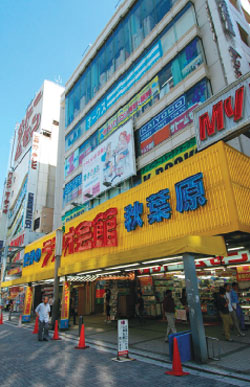
Radio Kaikan
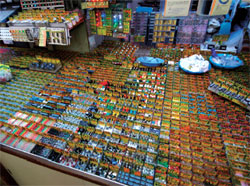
Electronic parts on display
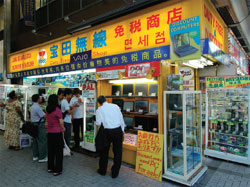
Duty-free shop
C. Back Street Area
Small stores selling computer peripherals and parts, game software,and manga and anime fanzines crowd this area, a maze of buildings and alleyways. There are also many restaurants.
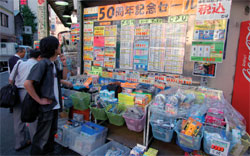
Shop selling computer peripherals
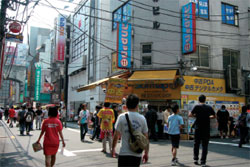
The road is closed off to vehicles, creating a "pedestrian paradise."
D. Redevelopment Area
Among the new additions to the area are Akihabara Crossfield, which is striving to become a major hub of Japan's IT industry, the Tsukuba Express train line, which opened for service in August 2005, the newly opened Central Exit of JR Akihabara station, and the household appliance retailer, Yodobashi Camera, which opened in September 2005.
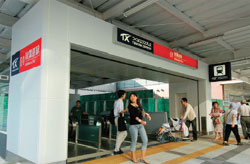
Tsukuba Express entrance
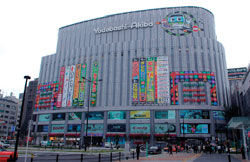
Yodobashi Camera
Akihabara today is called Otaku Town.But what exactly
is otaku ? Its original usage is as a slightly honorific word used
to address someone with whom one is not very familiar. In the early 1980s,
the custom among anime and science fiction buffs of calling each
other "otaku," morphed into a term referring to passionate
fans of anime, live-action "special effects" TV dramas,
manga, and/or computer games. Ever since this term was appropriated
for this usage, there has been a biased perception of otaku as being
introverted, gloomy, lacking in sociability, and exhibiting poor taste in
clothes.
Today, however, anime and manga
have become firmly established as widely popular genres especially among youth,
and it is difficult to come up with a typical otaku image. For example,
at Comic Market (known also as Comike, a manga fanzine exhibition
and sale held in Tokyo twice a year), approximately 35,000 amateur groups sell
their work, and about 500,000 visitors attend the event during the three-day
period. Both male and female otaku gather at Comike from
all over Japan, but many participants appear to enjoy socializing with each
other, and their fashion tastes are diverse.
Many of the Japanese anime and manga creators whose works
are widely known around the world today are so-called otaku.
For the very reason that they are otaku, or in other words, consumers
with a critical eye, they are able to understand and express precisely what
other consumers seek. It could be said that otaku are people who
can become completely absorbed in particular things or ideas.
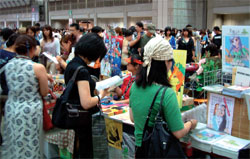
Comike
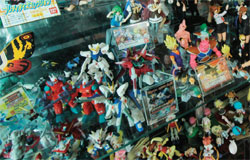
Figurines and dolls
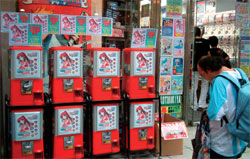
Anime-related goods store
Otaku who flock to Akihabara in search of electronic
parts, computer parts, anime and manga fanzines, game software,
and aidoru photo collections are known as "Akiba-kei (Akihabara-type
otaku)."
In June 2005, the movie Densha otoko
(Train Man) about an Akiba-kei character became a huge hit. Over one million
people saw the movie. The book, Densha otoko (Shinchosha, October
2004), on which the movie was based, is a love story originating in bbs messages
on the Internet, and has sold over one million copies. The book was also made
into a television series aired July to September 2005, which showed viewer
ratings of 20 percent, the highest of any television serial dramas aired during
that three-month period. The show popularized an expression frequently used
on Internet bbs sites, through scenes in which the characters scream "kitaaaa"
(I've got it!) when they are moved or excited.
Data
According to research conducted by Nomura Research Institute, the "otaku population (Japanese's mania consumer population)" is define das consumers who partake in consumption behavior dictated by their own individualistic values in placing priority on money and time. The study showed that in the five areas of comics, anime, games, aidoru ("idol" TV personalities), and PC assembly, they account for a market of approximately 290 billion yen. Furthermore, the study found that this population exerts a strong influence on the rest of society due to their high Internet usage and generation of information. They were also found to forge groups that span related fields. The otaku are an enthusiastic consumer population, and are said to be valuable driving force behind the next generation of technological innovations.
| Estimated Market of Otaku Population | |||
| Field | Population (thousand) |
Market size (billion yen) |
Major indices used |
| Anime*1 | 200 | 20 | DVD sales per title |
| Aidoru*2 | 800 | 60 | Size of concert audiences,sales of first-release CD's |
| Comics*3 | 1,000 | 100 | Number of participants in spot sales of fanzines, magazine subscriptions rate |
| Games*4 | 800 | 78 | Number of hours spent playing games,circulation of magazines |
| PC Assembly*5 | 50 | 32 | Sales at PC parts shops in Akihabara, circulation of magazines |
| Total | 2,850 | 290 | |
*1 Anime enthusiasts who spend their
time watching anime films, TV animation, and OVA (original video
animations)
*2 Person who actively collects information on
and participates in fan activities relating to a particular artist or media
personality and gives high priority to those activities on a daily basis.
*3 Persons who participate in comic coterie magazine
spot sales and/or contribute to comic coterie magazines.
*4 Heavy users of video games who spend the bulk
of their time playing games (for home use, via PC, on networks, or in game
arcades).
*5 Persons interested in personal computers, not for their use in writing
or other uses,but out of fascination with the assembly process.
Source: "The Otaku Group from a Business Perspective: Reevaluation of Enthusiastic Consumers" (Nomura Research Institute, Ltd., August 24, 2004)
The Tokyo Metropolitan Government sold the former site
of the Kanda Produce Market (approximately 16,000 square meters) located next
to JR Akihabara station to private contractors for redevelopment, and now
Akihabara is being transformed from an electronics district into a major hub
of the IT industry. The redevelopment area is called "Akihabara Crossfield,"
*comprised of two high-rise buildings, Akihabara
Daibiru (completed March 2005), a base for industry-university tieups and
information networks, and Akihabara UDX (to be completed in March 2006), equipped
with convention halls and event space. The Daibiru offers space to universities
and corporations. In addition, in April 2005, Digital Hollywood (Tokyo) opened
the University of Digital Content, the first university established by a company.
This university strives to nurture contents creators such as designers, producers,engineers,
and game creators.
With the founding of the university, Akihabara
is likely to attract attention as an educational district. Furthermore, with
the Tsukuba Express connecting Akihabara to Tsukuba Science City**
now in operation, Akihabara's role as a base for industry-academia cooperation
is expected to grow. The Akihabara station area has seen many other changes,
including the recent opening of the large-scale appliance retailer, Yodobashi
Camera, with Japan's largest sales floor space at 23,800 square meters.
Akihabara will continue to develop into an increasingly attractive city as
it advances towards its goal of becoming a premier center not only of hardware
such as electrical equipment, but also of digital content.
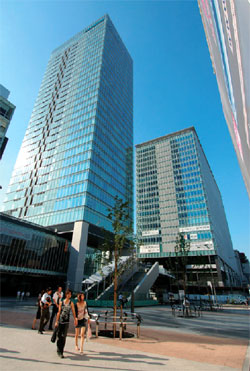
New buildings
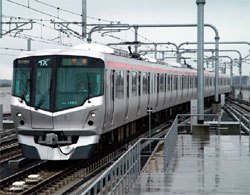
Tsukuba Express
Photos: Hongo Jin, TJF
*Akihabara Crossfield Website ⇒http://www.akiba-cross.jp/
**The development of Tsukuba began approximately
forty years ago. Currently in Tsukuba, there are close to 300 research institutes
and corporations, both public and privately owned, and approximately 13,000
researchers. It is Japan's largest repository of science and technology.
Original text : Takarabako No.06 "Feature" December 2005.
Copyright(C)1997-2008 The Japan Forum. All rights reserved.
Send feedback to forum@tjf.or.jp